Oral fluids and meat juice may hold answers to PEDV herd immunity
Oral fluid-based testing is an easy and “animal-friendly” approach for routine surveillance of porcine epidemic diarrhea virus in swine populations.
June 4, 2019

By Korakrit Poonsuk, Luis Giménez-Lirola and Jeffrey Zimmerman, Iowa State University
Porcine epidemic diarrhea virus has caused devastating losses at the global level. Highly transmissible and stable in the environment, PEDV has moved rapidly across pork-producing regions of the world. The exception to the rule, Canada has been effective in their efforts at slowing the spread of PEDV and their attempts at eradication may ultimately succeed. The Canadian effort is based on extensive PEDV real-time reverse transcriptase-polymerase chain reaction testing of animals, farms, and the production chain, i.e., livestock assembly yards, abattoirs, truck wash stations and livestock trailers.
If control and elimination is successful, other regions may choose to follow suit. However, PEDV will not be eradicated from the United States any time soon and will continue to circulate widely in swine populations in much of the world as far as we can see into the future. Thus, inexpensive-yet-effective surveillance methods are needed at the farm and regional levels to track PEDV for what is likely to be a long-term effort at prevention, control and possibly eradication.
On the farm, detection of PEDV using RT-rtPCR is highly effective at the time clinical signs are observed because animals are shedding high levels of virus. However, post-weaning PEDV infection is often “silent,” i.e., does not produce overt clinical signs, and the virus circulates undetected until the next outbreak. With or without clinical signs, antibody testing is highly effective at identifying virus-exposed populations because it does not require the presence of viral RNA. Likewise, antibody-based testing allows for monitoring herd immune status.

PEDV antibody enzyme-linked immunosorbent assays have been validated for several diagnostic specimens: serum, oral fluid and mammary secretions. In particular, oral fluid-based testing is an easy and “animal-friendly” approach for routine surveillance of PEDV in swine populations. Since PEDV infection occurs in the gut and stimulates mucosal immunity, the concentration of Immunoglobulin A is higher and detectable for a longer period of time in oral fluids and mammary secretions than Immunoglobulin G. The duration of detection has not known, but PEDV IgG and IgA antibodies can be detected in serum and oral fluids for at least four months after exposure. In contrast, IgA in colostrum and milk can be detected for at least 12 days post-partum whereas IgG in colostrum and milk can be detected for shorter period, i.e., for only three days after birth.
Alternatively, meat juice-based testing presents significant advantages for specific applications, e.g., for program diseases. Porcine muscle specimens are readily (and cost-effectively) collected at the abattoir. “Meat juice” — the transudate produced when frozen muscle tissue thaws — consists of intracellular fluid, extracellular fluid, blood and lymph. Likewise, meat juice contains antibodies and meat juice antibody ELISAs have been used for monitoring several infectious diseases, including PRRSV, influenza A virus, Mycoplasma hyopneumoniae, Salmonella spp., Trichinella spp., Yersinia enterocolitica and Toxoplasma gondii . In our studies, PEDV antibody was readily detected in meat juice specimens using the same PEDV IgG and IgA ELISAs used for serum and oral fluid testing.
Thus, the technology exists to perform routine PEDV surveillance using oral fluids and/or meat juice specimens. The availability of diagnostically sensitive and specific PEDV ELISAs for either IgG or IgA detection in oral fluid and meat juice specimens means that screening and confirmatory assays are already available. This approach should be given consideration if the industry elects to intensify efforts to monitor and/or control PEDV.
Sources: Korakrit Poonsuk, Luis Giménez-Lirola and Jeffrey Zimmerman, who are solely responsible for the information provided, and wholly own the information. Informa Business Media and all its subsidiaries are not responsible for any of the content contained in this information asset.
You May Also Like



